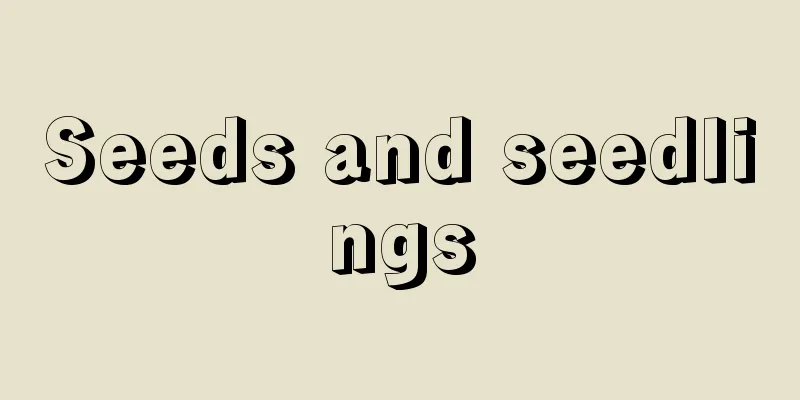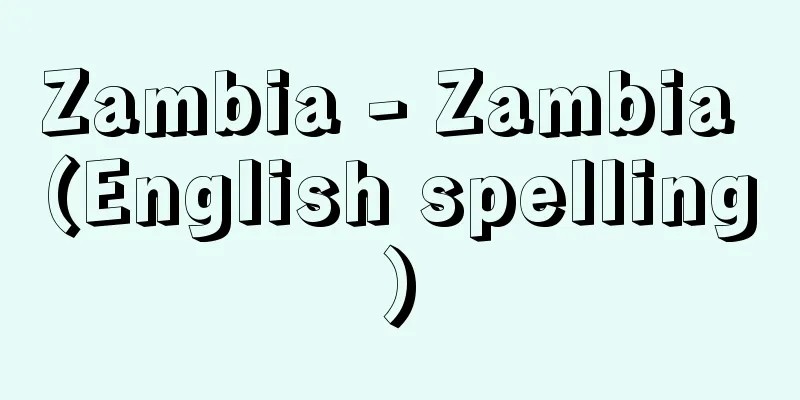Seeds and seedlings

|
These are so-called seeds and seedlings, which are the basis for the propagation and growth of agricultural products. They also refer to young fish and eggs for aquaculture. What is generally called a seed includes those that use true seeds in the botanical sense (such as beans, melons, plants of the Brassicaceae and Solanaceae families, cotton, sesame, poppy, morning glory, and snapdragon), those that use whole or part of a fruit that encases a seed in the botanical sense (such as wheat, corn, buckwheat, hemp, carrot, burdock, cornflower, and cineraria), and those that use a fruit that is further encased in appendages (rice seeds, barley, spinach, and Swiss chard). The advantages of using seeds include the ease of propagation, allowing many individuals to be obtained at once, the convenience of transporting and propagating to distant places, and the possibility of cultivating superior varieties through cross-breeding. The use of first generation hybrid ( F1 ) seeds has become widespread and is used for many grains, vegetables, flowers, and other crops. However, seeds cannot be used for sterile or parthenocarpic crops (where fruit develops without producing seeds). For crops where it is difficult to obtain seeds, parts of the vegetative organs are used. These are called seeds. Stems that can be used for seeds include aboveground stems, rhizomes, tubers, corms, and bulbs, and all of these are grown using the growth of their adventitious buds. Root tubers, branch roots, and swollen taproots are used for roots, and the adventitious buds that grow on these are used. In horticulture, rhizomes and tuberous roots that have swollen into a spherical shape are called bulbs. For plants with leaves that have a strong ability to regenerate, leaf cuttings are used. In addition, in the case of division, the cut stump (the combination of roots, stems, and leaves) is used as the seed. The part of the vegetative body used for seeds is largely determined for each crop, depending on the difficulty of propagation, cultivation conditions, and purpose. The advantage of using vegetative bodies as seeds is that individuals with completely uniform genetic qualities can be obtained in a short period of time. The most important thing about seeds is that they genetically possess the correct characteristics of the variety. They must also grow well and be uniform after planting in the field. As the saying goes, "seedlings are half the crop," obtaining high-quality seeds is extremely important for crop cultivation. In Japan, the Seed and Seedlings Act sets certain standards, and seeds are inspected by the Ministry of Agriculture, Forestry and Fisheries or the Seed and Seedlings Management Center of the National Agriculture and Food Research Organization or the Livestock Breeding Center, an independent administrative institution, to check germination rates, the presence of contaminants such as different varieties or weed seeds, and the presence of pests and diseases. Because the development of new plant varieties requires special techniques as well as a great deal of effort, time, and money, there are legal systems in place to protect the interests of breeders of new varieties. In Japan, the Agricultural Seeds and Seedlings Act, enacted in 1947 (Showa 22), had a system for registering seed and seedling names. Meanwhile, internationally, the International Convention for the Protection of New Varieties of Plants (UPOV Convention; UPOV stands for Union internationale pour la Protection des Obtentions Végétales) came into effect in 1968. With international public opinion growing in favor of protecting new varieties, Japan ratified the convention in 1982. Prior to this, the Agricultural Seeds and Seedlings Act was revised and renamed, and the Seeds and Seedlings Act was enacted in December 1978. Its contents include the following: For the 467 agricultural, forestry and fishery plants designated by government ordinance, the following actions cannot be carried out for commercial purposes without the permission of the registrant: (1) the transfer of seeds and seedlings for a fee, or the production and import for the purpose of transfer for a fee; (2) the transfer of all or part of a plant body for a fee, other than seeds and seedlings, that can be easily propagated and are specified by the Ministry of Agriculture, Forestry and Fisheries ordinance, for example, the sale of seedlings or cut flowers propagated by cuttings from cut flowers of registered roses or carnations; and (3) the transfer of seeds of F1 varieties bred using registered varieties as parents for a fee. The period of protection was 15 years for general crops and 18 years for perennial plants. Following the amendment of the UPOV Convention in 1991, the Seed and Seedlings Law was amended in 1998. This expanded the range of plants that were protected and strengthened the breeder's rights of breeders of new varieties. The protection period has been extended to 20 years for ordinary plants and 25 years for perennial plants. In the 2005 amendment, the protection period was extended further to 25 years for ordinary plants and 30 years for perennial plants. Other systems for protecting new varieties include the Patent Act, which protects new plants, but the core of protection is the Seed and Seedlings Act. In addition, the country is a member of the International Seed Testing Association (ISTA), and is responsible for testing imported and exported seeds and seedlings. [Hoshikawa Kiyochika] There are two types of seedlings for organisms targeted for aquaculture: natural seedlings and artificial seedlings. All eels are natural seedlings, which spawn and hatch in the ocean, and the grown fry are collected to be used as seedlings. Most carp, goldfish, rainbow trout, red sea bream, flounder, and prawn are artificial seedlings, where parents are artificially raised and the fry obtained from them are used as seedlings. Although artificial seedlings of sweetfish can also be obtained, most are natural seedlings. Fry are generally used for seedlings, but eyed eggs are also used for rainbow trout. Since the yield of natural seedlings varies greatly from year to year, attempts have been made to produce artificial seedlings for eels as well. To produce seedlings artificially, it is first necessary to clarify the life cycle of the organism, and then, based on that, solve various problems such as parent fish cultivation, maturation, spawning, fertilization, egg development, hatching, rearing of larvae, and transport of seedlings. [Yoshiaki Deguchi] [Reference] | | | | | | | |Source: Shogakukan Encyclopedia Nipponica About Encyclopedia Nipponica Information | Legend |
|
いわゆる種(たね)と苗で、農産物の繁殖や生育のもとになるもの。また養殖用の稚魚や卵のこと。 一般に種とよぶもののなかには、植物学上の真の種子を用いるもの(マメ類、ウリ類、アブラナ科やナス科の植物、ワタ、ゴマ、ケシ、アサガオ、キンギョソウなど)のほか、植物学上は果実全体あるいは果実の一部が種子を包んだもの(コムギ、トウモロコシ、ソバ、アサ、ニンジン、ゴボウ、ヤグルマギク、シネラリアなど)や、果実をさらに付属物が包んだもの(イネの種もみ、皮麦、ホウレンソウ、フダンソウ)などがある。種を用いることの利点としては、繁殖が容易で一時に多くの個体が得られること、遠隔地への移動・伝播(でんぱ)に便利であること、交雑育種などにより優良品種の育成が可能であることなどがあげられる。一代雑種(F1(エフワン))種子の利用が盛んになり、穀物、野菜、花などの多くのものに用いられている。 しかし、不稔(ふねん)性作物や単為結果(種子ができずに果実が発達すること)するものでは種が利用できない。種を得ることが困難な作物では、栄養器官の一部を利用する。これらを種物(たねもの)とよぶ。種物となる茎には地上茎、根茎、塊茎、球茎、鱗茎(りんけい)などがあり、いずれもそれらの定芽の生育を利用する。根としては塊根、枝根、肥大直根が利用され、これらに生ずる不定芽を利用する。球形に肥大した地下茎や塊根などを園芸では球根とよぶ。葉が強い再生力をもつものでは葉挿しを行う。このほか株分けの場合は、切り分けた株(根、茎、葉の総合体)が種物とされる。種物に利用される栄養体の部分は、増殖の難易、栽培条件、目的などにより作物ごとにほぼ決まっている。栄養体を種物とすることの利点として、遺伝的素質の完全にそろった個体が短時日に得られることがあげられる。 種苗は、遺伝的にその品種の特性を正しく具備しているものであることがもっともたいせつである。また、畑に植えてから優れた生育をし、しかもそれらがよくそろっていなければならない。昔から苗半作といわれるように、作物栽培上優良な種苗を得ることはきわめてたいせつである。日本では種苗法により一定の規格を設けて、農林水産省や国立研究開発法人農業・食品産業技術総合研究機構の種苗管理センターまたは独立行政法人家畜改良センターで種苗検査を行い、発芽率、異品種や雑草種子などの夾雑(きょうざつ)物の有無、病害虫の有無などを検査している。 植物新品種の開発には特殊技術や多くの労力、時間、資金が必要であるため、育成された新品種には、法律的に育成者の利益を守る制度がとられている。日本では、1947年(昭和22)に制定された農産種苗法に種苗名称登録制度があった。一方、国際的には「植物の新品種の保護に関する国際条約」(UPOV(ユポフ)条約。UPOV=植物新品種保護国際同盟Union internationale pour la Protection des Obtentions Végétalesの略称)が1968年に発効した。新品種保護に対する国際的世論の高まりのなかで、日本は1982年に条約を批准した。これに先だって農産種苗法が改正・改題され、1978年12月に種苗法が制定された。その内容として、次のようなことが定められた。政令で指定する467種類の農林水産植物については、登録されている品種は登録者の許諾なしには営利目的での、(1)種苗の有償譲渡、有償譲渡のための生産および輸入、(2)種苗以外のものでも、植物体の一部で容易に繁殖できるもので農林水産省令で定めるものについては、その植物体の一部または全部を有償で譲渡すること、たとえば、登録品種のバラやカーネーションの切り花から挿木などで増殖してできた苗や切り花を売ることなど、(3)登録品種をF1品種の親として育成されたF1品種の種子を有償譲渡すること、などの行為はできないことになった。保護の期間は一般作物が15年間、永年性植物が18年間であった。その後、1991年のUPOV条約改正を受け、1998年(平成10)に種苗法が改正された。これにより保護対象となる植物が拡大、また新品種の育成者がもつ育成者権が強化された。保護の期間は延長され、一般植物は20年、永年性植物が25年となった。2005年(平成17)の改正では保護の期間がさらに延長され、一般植物は25年、永年性植物は30年となっている。ほかに新品種保護の制度としては、特許法により新植物を保護することが行われているが、保護の中心は種苗法にあるといえる。また、国として国際種子検査協会International Seed Testing Association(ISTA)に加入して、輸出入種苗についても検査をしている。 [星川清親] 水産増養殖の対象となる生物の種苗には、天然種苗と人工種苗がある。ウナギはすべて天然種苗で、天然の海洋で産卵・孵化(ふか)し、成長した稚魚を採集して種苗としている。コイ、キンギョ、ニジマス、マダイ、ヒラメ、クルマエビはほとんどが人工種苗で、人工的に親を飼育し、これから得た稚魚を種苗とする。アユは人工種苗も得られるが、主体は天然種苗である。種苗には一般に稚魚が用いられるが、ニジマスでは発眼卵もあわせて用いている。天然種苗は年により豊凶の差が甚だしいので、ウナギでも人工種苗を生産する試みがなされている。人工的に種苗を生産するためには、まずその生物の生活史を明確にし、それを基盤として、親魚養成、成熟、産卵、受精、卵の発生、孵化、仔稚魚(しちぎょ)の飼育、種苗輸送などの諸問題を解決する必要がある。 [出口吉昭] [参照項目] | | | | | | | |出典 小学館 日本大百科全書(ニッポニカ)日本大百科全書(ニッポニカ)について 情報 | 凡例 |
>>: Shuhiyushi (English spelling) zhū pī yù zhǐ
Recommend
Tsukumi [city] - Tsukumi
A city facing Tsukumi Bay in the eastern part of O...
Tachibana - Kissei
…Also, in the Shenxian Biography, the Han Dynasty...
New Order in East Asia
During the Second Sino-Japanese War, Japan advoca...
Edigyu - Edigyu
...They speak the Turkic language Nogai, and in t...
Krzenek
An Austrian Jewish composer, also known as Kuchene...
Educational system - student
This law established Japan's first modern sch...
Integrable - Integrable
...When f is unbounded, we define f n ( x ) = min...
Bromhidrosis
…Medically, it is called bromhidrosis. It is a co...
landscape design
…Until then, it was called saku seizai (landscape...
National Stadium - National Stadium
A special corporation and the stadium under its j...
Koshi-ko - Kinoeneko
…He was also worshipped as the god of the fields,...
General equilibrium theory
...While national income statistics observe the m...
Poecilasma obliquum (English spelling) Poecilasma obliquum
…[Shigeo Gamou]. … *Some of the terminology expla...
Allegheny River - Allegheny
…a river in the northeastern United States. It be...
Radio Star - Denpasei
Also known as radio object or radio star. A genera...









